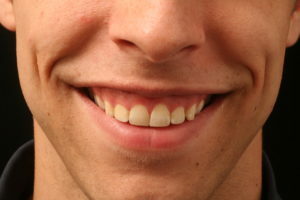 Smile - is not only an arbitrary contraction of the muscles of the face, but also a universal means of communication. Smile is a unique communication tool: it expresses emotions, beautifies a person, speaks of the location and friendliness.
Smile - is not only an arbitrary contraction of the muscles of the face, but also a universal means of communication. Smile is a unique communication tool: it expresses emotions, beautifies a person, speaks of the location and friendliness.
By the nature of the smile you can understand the mood of the interlocutor. A person who knows how to smile beautifully and correctly in a given situation can count on success in life.
But it also happens that the person is embarrassed by his smile and hides it. The reason for this can serve as a defect, like a gingival smile. According to statistics, up to 15% of the population live with such a smile.
Content
- Features gingival smile
- causes of defects
- Who should make the correction smiles
- What are the methods of correction, their postoperative period
- Cosmetic Botox Correction
- Increased lip gel
- Plastic frenulum of the upper lip
- Closure orbicularis oris muscle
- Laser correction of gingival margin
- Orthodontic treatment
- Maxillary osteotomy and mandibular osteectomy
- Cost of gingival smile correction
- Lenia patients
Features gingival smile
gingival or gingival smile( from the English «gummy smile».) - is when you smile can be seen the upper gums, popularly referred to as 'horse'.This defect is neither pathology nor disease, but is only an aesthetic problem that can be corrected.
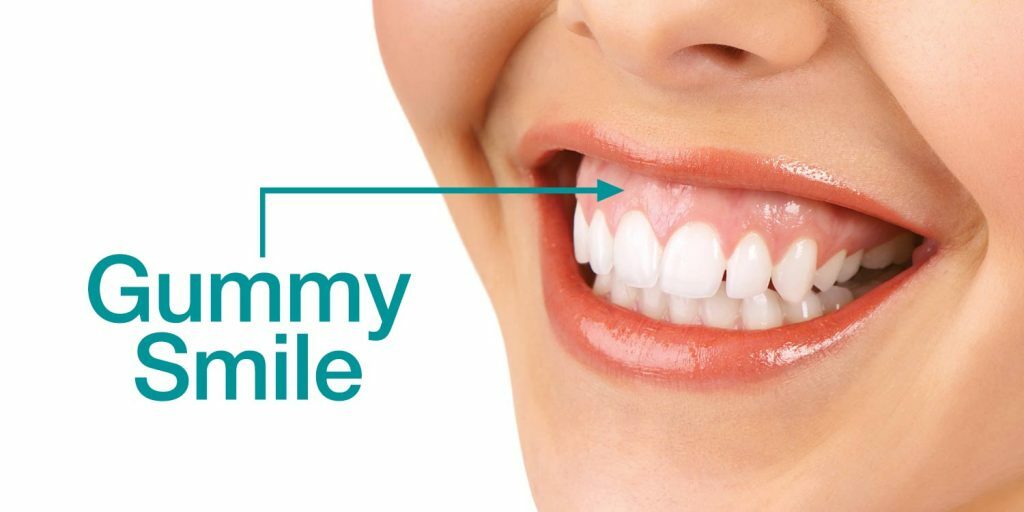
The specificity of teeth and gums opening with a smile depends on the face, teeth, lips and condition of the gums. Hollywood is a smile that barely reveals the upper incisors, while the lower ones are either not visible, or almost invisible. It is allowed to expose the gingival margin to 3 mm. If the denudation is above the norm, this is considered a cosmetic defect.
You can diagnose the defect yourself, smiling in front of the mirror. If the gum is bared at 2-3 mm, it's gummy smile. The flaw is evident even in childhood. In this case, the child should be shown to the dentist to determine the cause of the defect and the choice of the correction method.
Causes of the
Defect The most common cause of the defect is a very large gum that covers the teeth more than the intended one, or a short upper lip.
A strongly noticeable gingival smile is a consequence of a defect in the facial skeleton or an unusual bite, when the middle facial area is larger, and the upper incisive teeth are shifted to the bottom or vice versa go forward.
In 10% of the adult population, this flaw occurs after trauma or poor-quality face plasty.
Basically, the presence of a gingival smile is explained by the anatomical features of a person's face, namely:
- a unique structure of the maxillofacial device;
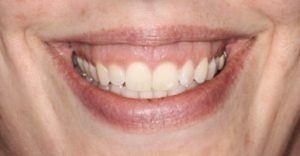
- wrong position of the teeth;
- muscle hyperactivity of the upper lip;
- non-standard occlusion formation;
- lip is shorter than usual;
- small upper incisors.
Who needs to make a smile correction
From the physiological point of view, there is nothing wrong with a gingival smile. Such a smile is just a specific feature of a person's structure and does not cause him any discomfort or harm.
There is a public opinion that the most beautiful is considered a smile without exposing the gums or to an insignificant extent. In this regard, many independently decide how to perceive this anatomical structure: as a highlight or as a flaw, which should be corrected.

At the same time, some patients are being corrected for dental reasons. For example, after the treatment of periodontal diseases.
What are the methods of correction, their postoperative period
Depending on the reasons for the formation, smile correction can be performed by different methods. Use orthodontic and surgical therapy, or a set of cosmetic procedures.
Treatment of gingival smiles requires rehabilitation, which can last from 7 days to several months, depending on the degree of complexity of the correction method.
Cosmetic correction by Botox
This is an injection of the preparation into the folding area between the nose and lip. Botox immobilizes muscles by blocking the susceptibility of nerve impulses. After the procedure, the lip remains not moving and does not expose the gum.
Recommendations after the injection procedure:
- 4 hours in an upright position;
- for 2 days are forbidden physical activity;
- will have to wait with a facial massage;
- for 2 days try not to smile;
- can not be soared and sunbathing for 7 days.
After 10-14 days, you need to re-see the doctor. In total, up to 3 injections are required. The effect is visible in a few days and lasts up to six months. Then the procedure must be repeated.
Advantage of the method:
- without pain;
- reasonable price;
- there is no difficulty in conducting;
- rapid healing.
Increased lip volume
gel The elimination of the defect will allow the introduction of a special gel. A gentle procedure that makes the lip more and less active. With a slight defect, the result is noticeable. This method is carried out either alone or in combination with other procedures.
After the procedure, it is impossible:
- use cosmetics during the day;
- use hot drinks, alcohol and smoking;
- go to saunas, baths or sunbathe for 2 weeks.
For faster action of the drug immediately after the injection requires special massage. To exclude the possibility of asymmetry, you need to re-inject after 2-3 weeks.
Gel injections have an instant effect and it lasts, depending on the type of drug, from 1 to 5 years after administration.
Advantage of the method is comfort, speed( maximum 30 min.) And painless procedure. The disadvantage of the method is a slight change in appearance.
Plasticity of the bridle of the upper lip
The correction of the bridle by the plastic method extends the upper lip and reduces its activity. The postoperative period is calm. After the end of the anesthetic, there may be pain in the surgery site.
All recommendations are reduced to such measures: 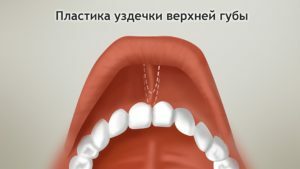
- regular oral hygiene;
- for 2 days you can not eat solid and hot food;
- in the presence of complaints or discomfort should be observed at the surgeon for 1-2 weeks;
- perform miogymnastiku for activation of blood circulation and muscle development.
Sewing of the circular muscle of the mouth
With hyperactivity of the circular muscle, surgical plastic is performed to suture it. Under local anesthesia, an incision is made under the lip near the upper row of teeth. After sew the muscle and mucous, while shifting the flap. The method is traumatic, but effective. The muscle tissue after the procedure relaxes, and the gum stops being denuded.
After the operation it is necessary to adhere to the following recommendations:
- reception of painkillers and antibacterial drugs 2 times a day( Ibuprofen and Amoxicillin);
- 2 times a day, rinse the mouth with a solution of Chlorhexidine;
- removal of stitches on the seventh day after correction;
- follow-up inspection after 8 weeks.
The operation is almost a safe procedure in surgery. But there are a number of possible complications: discomfort, bleeding in the skin or mucous( bruises) and swelling of the upper lip.
Laser correction of the gingival edge
If the anatomical feature appears due to hyperplasia, then a simple and painless technique is performed using a laser. The excess tissue cover of the gums, covering the teeth, is removed. After the procedure, the gum becomes permanently smooth with a neat contour. Advantages of laser plastics:
- excludes bleeding and traumatism of adjacent areas;
- high accuracy correction of the necessary tissues;
- incidental destruction of pathogenic bacteria and sanitation of the oral cavity;
- rapid healing of tissue cover.
Necessary recommendations to avoid inflammation:
- to reduce the use of sweets;
- to carry out regular sanation of the oral cavity regardless of food intake;
- get rid of bad habits;
- regular visit to the dental office every six months.
Orthodontic treatment
An incorrectly formed bite requires therapy by installing braces, caps and other special designs. With their help, the displacement of the teeth is achieved, the slope changes and the height of the gum edge decreases. The process of correction is long, can last 1-3 years.
Before installing braces, caps or other structures, it is recommended to remove wisdom teeth, even those not yet cut. The risk of damage to their caries is possible.
Before correction of the bite, all teeth must be cured. Orthodontic treatment may also require correction of soft tissues of the oral cavity.
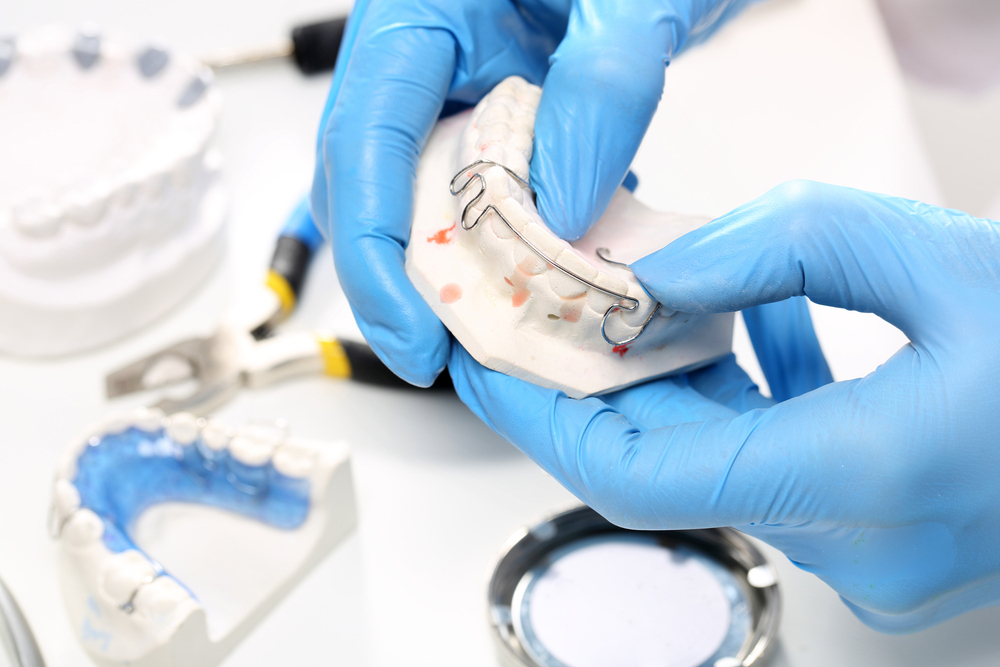
In the first few days, discomfort is possible, as the elements of the system "tighten" the teeth in the required direction.
Recommendations and advice after the procedure for orthodontic treatment:
- during the wearing of braces you need to thoroughly and regularly brush your teeth with special means;
- it is necessary to exclude viscous, hard, too sweet food, strong black tea and red wine;
- should include foods high in vitamin C, calcium and magnesium in the diet;
- when pain occurs, take pain medication;
- when irritating the oral mucosa, use a special ointment recommended by a doctor;
- when the structure is displaced, it is necessary to consult a specialist;
- need to visit orthodontist every 3-7 weeks or on an individual schedule.
In rare situations, the metal parts of the structure may become unstuck or bent. It is necessary to inspect the system every day. With proper and regular care for 1-2 years, you can correct various tooth defects.
Maxillary osteotomy and mandibular osteectomy
In extremely difficult situations, a procedure is used to change the skeleton of the face. An operation is performed to shift the upper teeth to the highest location and change the position of the lower jaw. This method is rarely resorted to in exceptional cases, if otherwise it is impossible to eliminate the defect.
The procedure is characterized by a long and difficult recovery period of 2-3 weeks. From the first day the antibacterial course begins and a pressure bandage is applied, which is removed one day after the manipulation.
After a month, medical treatment is supplemented with exercise therapy, massage, facial gymnastics and physiotherapy. In complex cases, rehabilitation may last for up to six months.
Elastic bands are placed between the teeth to fix the jaws. The specialist conducts regular monitoring of their location and the state of bite. During this period it is forbidden to chew, blow your nose and open your mouth wide. After 10-14 days, the stitches are removed, and after 3-4 months the screws from the gums are removed.
Undesirable effects can be:
- bruises;
- puffiness and local numbness of tissues;
- speech problems;
- difficulty in chewing, swallowing and hygiene of the mouth;
- improper splicing of bone tissue with increased load on the operated zone.
This operation has several advantages:
- chewing functions become better;
- improves the appearance, the lower jaw no longer protrudes, the bite is normal;
- restores the symmetry of the face as a whole;
- reduces the chance of developing jaw pathologies.
The technique of osteotomy is a safe surgical operation that helps to change the appearance for the better.
Cost of gingival smile correction
The price of correction depends on:
- techniques and technologies used to repair the defect;
- pathological manifestations;
- prestige of the dental clinic;
- qualification specialists.
In Russia, the average cost of correcting the gingival smile, depending on the method of correction, varies from 15,000 rubles.up to 350 000 rubles.
Impressions of patients
Some correction methods are very complex and have a long recovery period. You need to take a very careful look at the choice of a specialist and how to correct the defect. Photos before and after fixing the gingival smile and the responses of some patients will help a little to solve the problem.

The correction of the frenum helped to remove my defect. The lip became lower, and the upper gum ceased to be denuded. A friend with the same flaw had a different effect: the lip was on the contrary to bully up. Choose a doctor who understands this issue.
Tonya, 42
I underwent a very difficult technique - correction of gingival smiles, resorting to surgical intervention. The result was pleased, but it's very difficult, especially to model a smile with the help of nanotechnology. After the procedure, the expected result was not similar to me. You have to trust yourself to a specialist, but what can you do? Healed everything super. After the operation, the second problem - the protruding roots of the upper teeth - was eliminated, they ceased to be visible, and were satisfied.
Ivetta, 28
I want to say that I was afraid to smile, but still I went to a specialist who has long been treating my teeth. He gave directions to the orthodontist, who said that braces would help me. It helped me.
Marianne, 31
Laser correction corrected the defect. Everything turned out all right. After she showed herself to the doctor and carried out all the recommendations. Later she bleached, as the teeth were whiter under the gums. Very satisfied!
Anna, 29
In terms of medicine, a gingival smile does not have to be subject to correction. Some methods of correction have a long rehabilitation period and a complex recovery. But for aesthetic reasons, such a flaw can be removed.
It is important to remember that any surgical intervention in the human body can cause negative consequences, but possible risks are minimal if you contact a qualified specialist.
